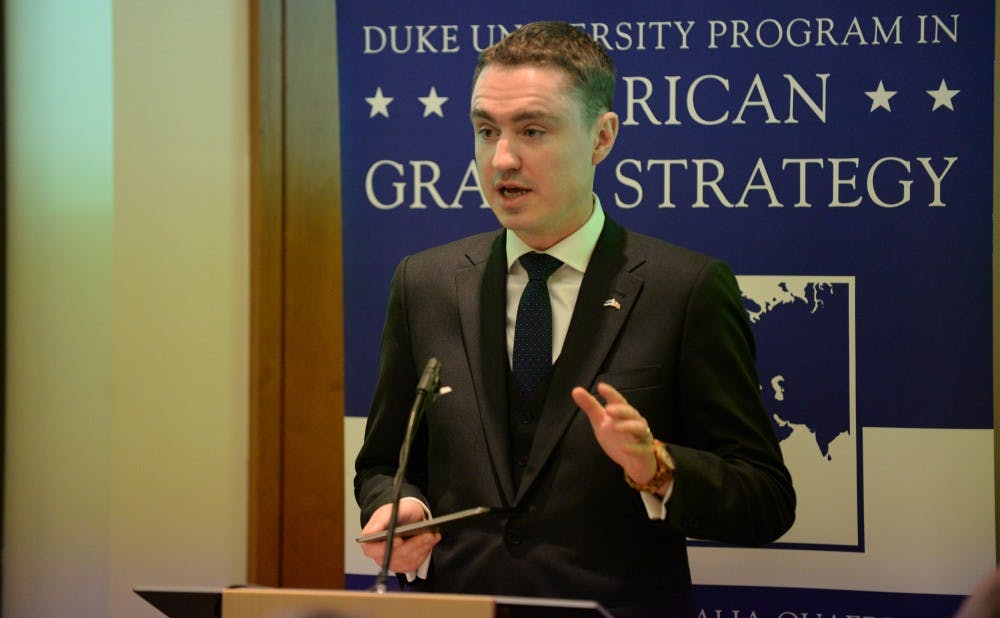Estonian Prime Minister Taavi Rõivas visited Duke Wednesday to discuss how his government has used technology to improve its citizens’ lives.
Rõivas—the youngest leader in the European Union—delivered a talk at the Sanford School of Public Policy called, “A 21st Century State: Anything is Possible.” He explained that his country’s emphasis on national security, fiscal prudence, a free-market economy and technology are the reasons for Estonia’s significant economic growth since regaining independence in 1991.
“Even though Estonia is a small country quite far from North Carolina, we actually are a European version of the American dream,” he said.
Rõivas’ talk focused on Estonia’s use of e-government programs, which allow citizens’ interactions with government to occur primarily online. The programs have made life simpler for Estonians since their adoption in 2000, Rõivas said.
“The idea of using technology is not just having fancy gadgets and interesting information systems,” he said. “All the use of technology is not only because we are extremely tech-savvy, but mainly because we are practical people.”
Rõivas said technology plays a fundamental role in Estonia. He noted that the Internet is a human right for Estonians and that the country is a founding member of the Digital 5—a group of leading e-governments around the world that also includes South Korea, Israel, New Zealand and the United Kingdom.
He explained that under the e-government systems, every Estonian citizen is given an identification card with a cryptographic key that serves as a digital identifier that can be inserted into electronic devices. Together with an individual PIN number, this creates a two-way authentication process that allows access to Estonia’s numerous e-services.
The goal is to reduce the “inevitable burden” that government frequently poses, Rõivas explained, noting that the country’s digital system ensures that multiple government agencies will not have to repeat themselves.
“The government shouldn’t ask you anything you have already told them,” he said.
Rõivas emphasized that it takes only a couple of hours to register a fully-functioning, legal company online and about three minutes to do taxes online. Estonia currently has the largest start-up per capita ratio in Europe, he noted, adding that new ventures have proliferated in Estonia since Skype was created by three Estonian programmers in 2003.
Another key attribute of Estonia’s e-government programs is the cost-saving use of cryptographically-protected digital signatures, he said. The country saves 2 percent of gross domestic product every year through time savings and reduced paperwork, allowing it to redirect funds to other issues such as national defense.
“I can sign things anywhere, including in the back seat as I drive here from the airport,” he explained.
Rõivas added that the use of digital signatures is widespread and that anyone can use them for any purpose except for two—real estate contracts and weddings.
“Even in Estonia, you have to show up,” he joked.
Since 2005, voting online has become an alternative option to voting in person, and one in every three votes is cast this way, Rõivas said. This proved useful in the 2015 parliamentary elections, in which Estonian citizens located in 126 countries cast ballots, he explained.
The technology is also used in the nation’s health care sector, simplifying communications between hospitals and doctors.
Rõivas acknowledged that relying on e-services creates concerns about cybersecurity. He noted, however, that Estonia has invested in this area to gain citizens’ trust.
There may be security benefits to having these e-services be accessible from multiple locations because there is not a central location that can be attacked, he added.
Rõivas, who came to the United States with a delegation of 30 Estonian government members, also discussed the important role that trade and international relationships have had on “making Estonia bigger”—which was one goal of his visit. As part of the trip, he met with Paul Ryan, speaker of the House of Representatives, and appeared Tuesday evening on “The Daily Show” with Trevor Noah.
E-government has allowed citizens from other countries to have access to Estonia’s e-services, which Rõivas said have been used by numerous CEOs around the world.
“We can’t grow the population in a very short time, so we need to be creative,” he said. “We invite all of you virtually to be a citizen, to run your business in Estonia.”
Rõivas added that if governments around the world are willing to take risks with technological innovation, successful e-governance could become universal and create tremendous benefits.
“If a country the size of Estonia saves 2 percent of GDP by signing things digitally, imagine how much we would save in efficiency gains if this would be global,” he said. “This is our goal, to first take it to Europe and then see what happens.”
Get The Chronicle straight to your inbox
Signup for our weekly newsletter. Cancel at any time.

